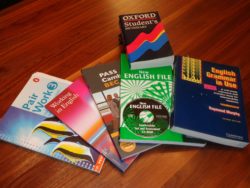I am happy to present a guest post by Nora Mork:

If you want to speak English well, you should learn some basic English idioms. Speaking naturally comes with slang as well. But before all that, you should focus on learning proper English grammar and correcting your grammar mistakes.
Here are some of the most common English grammar mistakes ESL learners make — and how they can avoid making them in the future so they can learn faster and gain more confidence:
1. May vs. Might
This is a tricky one because the difference is pretty small. Both words state that something is possible, but might is more uncertain than may.
So, keep in mind that saying that you may do something has more weight; it’s a lot more certain and stronger than saying that you might do something. Might should be used when what you say will maybe happen but then maybe it won’t.
May also turns into might in the past tense.
2. Fewer vs. Less
This is a mistake both native and ESL speakers make. These words both describe the opposite of more, but you need to keep the noun in mind when deciding whether to use fewer or less. Fewer is used for countable nouns — when you can count the number of things you are addressing. Less is used with uncountable nouns — something that can’t be used with a number in front of it like love, water, electricity, and so on.
3. Could, Should, Would
These sound the same but mean different things. Should is used when you give advice to someone. Would is used to describe situations that are unreal or unlikely and to make polite offers. Could can be used to describe a past ability, possibilities in the future, or to make polite requests.
4. Since and For
These words are both used in relation to time. For is used with a period or a duration of time, while since is used with an exact moment in time. For comes before expressions like 10 minutes, 6 months, and so on. Since comes before Monday, January, 1995, for example.
5. Bring or Take
These two words have almost the same meaning, but they have different directions.
Bring suggests that you are moving something to the speaker; you are bringing things to where you already are. Take means that you are moving away from the speaker. You take things with you, but people bring stuff with them to you.
6. Order of Adjectives
Keep in mind that adjectives — if there is more than one of them in a row — always go in the same specific order.
The normal order is
- Quantity or number
- Quality or opinion
- Size
- Shape
- Age
- Color
- Nationality
- Material
Not all of these are used at once; use three at most at the same time.
7. Me and Myself
When to use me and when to use myself is another big ESL problem.
“Well, me is an object pronoun which refers to the person the action is being done to – so use me when something is being done to you,” says Tiana Franklin, an educator at Bigassignments and Resumention. Myself is reflexive and generally only used in sentences that have I in them as well.
8. There, Their, and They’re
This is a common mistake even with native speakers. These words sound the same but are definitely not the same.
There is a place, or it is used with the verb to be. Their is a possessive adjective, which signals that something belongs to them. They’re is a contraction of they are.
9. Its vs. It’s
These two words often cause another mistake common with both native and ESL speakers. Its signals that something belongs to it. It’s is a contraction of it is.
10. A or The
There are many languages that don’t use definite and indefinite articles ,which means that many ESL learners will have trouble with this. When you are talking about something in a general way, you should use the “a” article, but when you are referring to something specific that everyone is familiar with, you should say “the.” Academ advisor and Revieweal might help you find out where to use a and where to use the in your conversations.
Learning a language is hard, especially English since there are so many differences in grammar from other languages. But you can manage to overcome these mistakes and become a more fluent speaker.
Nora Mork is an e-learning journalist and an ESL tutor at Oxessays. She helps ESL students achieve learning goals  by sharing her experience in lectures and language learning posts at such online magazines and blogs as Academized and Writemyaustralia.
by sharing her experience in lectures and language learning posts at such online magazines and blogs as Academized and Writemyaustralia.



Very good for ESL students.
Glad you liked it!
This article is too brief and begs for contrasting examples. You have to already know the language well to understand the meaning of the terse comments.